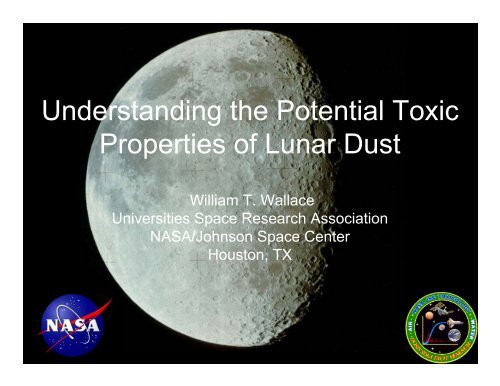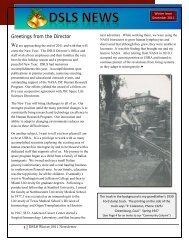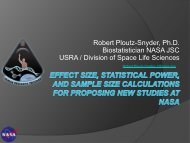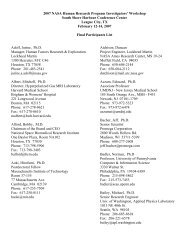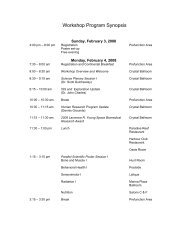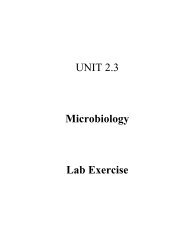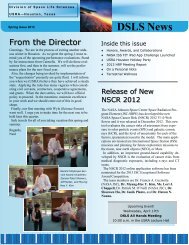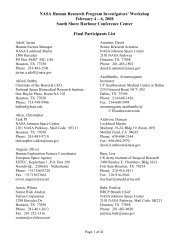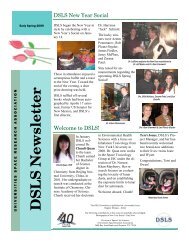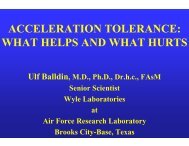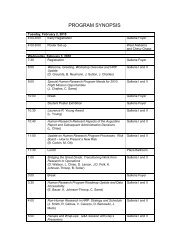Understanding the Potential Toxic Properties of Lunar Dust
Understanding the Potential Toxic Properties of Lunar Dust
Understanding the Potential Toxic Properties of Lunar Dust
Create successful ePaper yourself
Turn your PDF publications into a flip-book with our unique Google optimized e-Paper software.
<strong>Understanding</strong> <strong>the</strong> <strong>Potential</strong> <strong>Toxic</strong><br />
<strong>Properties</strong> <strong>of</strong> <strong>Lunar</strong> <strong>Dust</strong><br />
William T. Wallace<br />
Universities Space Research Association<br />
NASA/Johnson Space Center<br />
Houston, TX<br />
1
Outline<br />
• Motivation<br />
• Materials<br />
• Activation and Monitoring <strong>of</strong> <strong>Lunar</strong> <strong>Dust</strong> and<br />
Analogs<br />
– Fluorescence<br />
– EPR<br />
• Solubility Studies<br />
– ICP-MS<br />
• Cellular <strong>Toxic</strong>ity<br />
–A549<br />
2
“I think dust is probably<br />
one <strong>of</strong> our greatest<br />
inhibitors to a nominal<br />
operation on <strong>the</strong> Moon. I<br />
think we can overcome o<strong>the</strong>r<br />
physiological or physical or<br />
mechanical problems except<br />
dust.”<br />
Gene Cernan<br />
Apollo 17 Technical Debrief<br />
Words <strong>of</strong> Wisdom<br />
4
John Lindsey, LPI<br />
Pathway <strong>of</strong> <strong>Dust</strong> Introduction<br />
5
Jack Schmitt<br />
(Apollo 17)<br />
<strong>Lunar</strong> EVA Suits<br />
6
Problems Caused by <strong>Dust</strong><br />
• Obscured vision<br />
– Apollo 15: vision completely obscured below 60 ft when landing<br />
• Clogged equipment<br />
– Apollo 12: wrist and suit hose locks clogged with dust<br />
• Coated surfaces<br />
– Apollo 11: T.V. cable caused tripping after dust covering<br />
• Inhalation<br />
– Apollo 15: gunpowder smell<br />
– Apollo 17: “hay fever” symptoms<br />
• Degraded radiators<br />
– Apollo 16: degraded instrument performance from overheating<br />
• Fooled instruments<br />
• Caused seal failure<br />
– Apollo 14: measurable leaking <strong>of</strong> suits<br />
• Abraded surfaces<br />
– Apollo 16: gauge dials unreadable from scratching<br />
7
What is lunar dust?<br />
• <strong>Lunar</strong> soil is defined as <strong>the</strong> loose fragmental<br />
material with a grain size smaller than 1 cm on<br />
and near <strong>the</strong> surface <strong>of</strong> <strong>the</strong> moon. It is a subset<br />
<strong>of</strong> <strong>the</strong> lunar regolith which includes all size<br />
fragments including boulders.<br />
• <strong>Lunar</strong> dust is <strong>the</strong> finest size fraction <strong>of</strong> lunar soil.<br />
A working definition <strong>of</strong> lunar dust is that it is all<br />
grains smaller than 20 µm.<br />
8
<strong>Lunar</strong> <strong>Dust</strong><br />
• Contains Si-containing minerals, various oxides, and trace metals<br />
• Magnetic<br />
• Particles are oddly shaped, with jagged edges, and do not pack<br />
toge<strong>the</strong>r well<br />
Sarah Noble, MSFC<br />
9
Sarah Noble, MSFC<br />
<strong>Lunar</strong> <strong>Dust</strong> Rims<br />
50nm<br />
100nm<br />
Glassy rims produced by vapor/sputter deposition. Also contain ~ 10 nm<br />
Fe nanoparticles<br />
10
<strong>Lunar</strong> Soil Formation<br />
<strong>Lunar</strong> soil is formed by a combination <strong>of</strong> comminution (breaking down),<br />
agglutination (clumping toge<strong>the</strong>r), and vapor deposition.<br />
Larry Taylor, U. Tennessee<br />
11
Meteorite Impact on <strong>the</strong> Moon<br />
• 25 cm diameter meteorite traveling at 85,000 mph<br />
• Kinetic energy <strong>of</strong> impact: 17 billion joules (equivalent to 4 tons <strong>of</strong> TNT)<br />
• New crater: 14 meters wide by 3 meters deep<br />
• Flash only 0.4 seconds in real-time<br />
http://science.nasa.gov/headlines/y2006/13jun_lunarsporadic.htm<br />
12
Recent Impacts<br />
13
<strong>Lunar</strong> <strong>Dust</strong> Simulant (JSC-1A-vf)<br />
Only 842 lbs <strong>of</strong> material returned from <strong>the</strong> moon!<br />
Simulant material needed for preliminary studies.<br />
• Made from volcanic ash<br />
• 50% silicon-containing minerals<br />
• 42-45% o<strong>the</strong>r oxides (Al 2 O 3 , FeO, MgO, CaO)<br />
– Materials not pure oxides (mineral form)<br />
• No trace metals<br />
• Size distribution <strong>of</strong> particles similar to samples<br />
<strong>of</strong> lunar dust<br />
• 90% smaller than 13 µm diameter<br />
– 50% < 3 µm<br />
14
Sample<br />
JSC-1A-vf,<br />
% oxides<br />
Apollo 16<br />
Soil<br />
(62241), %<br />
oxides<br />
Min-U-Sil<br />
Quartz,<br />
%<br />
SiO 2<br />
48.77<br />
44.65<br />
99.0-<br />
99.9<br />
Al 2 O 3<br />
15.65<br />
27<br />
< 0.8<br />
TiO 2<br />
1.49<br />
0.56<br />
< 0.1<br />
D.S. McKay, et al., LPSC XXIV (1993) 963-964.<br />
H.J. Rose, Jr., et al., Proc. 4 th LSC 2 (1973) 1149-1158.<br />
Materials Used<br />
FeO<br />
8.88<br />
(+ 1.71%<br />
Fe 2 O 3)<br />
5.49<br />
< 0.1<br />
(Fe 2 O 3 )<br />
MnO<br />
0.19<br />
0.7<br />
0<br />
MgO<br />
8.48<br />
5.84<br />
0<br />
CaO<br />
10.44<br />
15.95<br />
0<br />
Na 2 O<br />
2.93<br />
0.44<br />
0<br />
K 2 O<br />
0.81<br />
0.13<br />
0<br />
P 2 O 5<br />
0.66<br />
0.1<br />
0<br />
15
<strong>Lunar</strong> <strong>Dust</strong> Activation<br />
• Constant activation <strong>of</strong> lunar dust by meteorites,<br />
UV radiation, and elements <strong>of</strong> solar wind<br />
• No passivating atmosphere<br />
• Active dust could produce reactive species in <strong>the</strong><br />
lungs<br />
– Freshly fractured quartz<br />
• Must determine methods <strong>of</strong> deactivation before<br />
new lunar missions<br />
• First, must understand how to reactivate dust on<br />
Earth<br />
16
What Does “Activated” Mean?<br />
• Presence <strong>of</strong> reactive sites on surface<br />
– Free radicals<br />
• Ability to produce reactive species in<br />
solution<br />
J. Narayanasamy and J.D. Kubicki, J. Phys. Chem. B 109 (2005) 21796-21807<br />
17
Previous Studies <strong>of</strong> Quartz Activation<br />
• Grinding quartz gives electron spin<br />
resonance (ESR) signal characteristic <strong>of</strong> Si· or<br />
Si-O· radicals<br />
• Increased grinding time produces higher<br />
signal<br />
• Decrease in Si-based radicals over time in air<br />
• Half-life <strong>of</strong> ~30 hours, with 20% <strong>of</strong> signal<br />
detectable even after 4 weeks<br />
• Ground quartz in aqueous solution produces<br />
OH radicals<br />
• Radical production decreases with exposure<br />
to air<br />
• Half life <strong>of</strong> ~ 20 hours<br />
V. Castranova, Environ. Health Perspect. 102 (1994) 65-68.<br />
V. Vallyathan et al., Am. Rev. Respir. Dis. 138 (1998) 1213-1219<br />
18
Activation Methods Tested<br />
• Crushing/Grinding<br />
• Mortar and pestle<br />
• Ball Mill<br />
• UV activation<br />
• Heating<br />
19
Fluorescence<br />
20
Hydroxyterephthalate as a Probe <strong>of</strong><br />
Hydroxyl Radical Generation<br />
COO -<br />
COO -<br />
Terephthalate<br />
(non-flurorescent)<br />
HO<br />
COO -<br />
COO -<br />
OH<br />
2-Hydroxyterephthalate<br />
(fluorescent)<br />
21
Emission Intensity<br />
(λ - 324 nm)<br />
ex<br />
Activity Comparison <strong>of</strong> Ground <strong>Lunar</strong><br />
120<br />
100<br />
80<br />
60<br />
40<br />
20<br />
Soil, <strong>Lunar</strong> Simulant, and Quartz<br />
Ground 62241<br />
Ground Simulant<br />
Ground Quartz<br />
Unground 62241<br />
0<br />
350 400 450 500 550<br />
Wavelength (nm)<br />
• 10 minute grinding<br />
• 3.8 mg/mL JSC-1A-vf<br />
• 10 mM Terephthalate<br />
22
A<br />
B<br />
Size Distribution and Surface Area<br />
after Grinding<br />
C<br />
ΔN / ΔLog(Dp)<br />
Size distribution <strong>of</strong> lunar dust particles (62241-<br />
1.8<br />
1.6<br />
1.4<br />
1.2<br />
1<br />
0.8<br />
0.6<br />
0.4<br />
0.2<br />
0<br />
Ground)<br />
0.01 0.1 1 10 100<br />
Particle diameter (μm)<br />
A: Min-U-Sil 15- 8.436 m2 /g<br />
(unground- 3.7 m2 /g)<br />
B: JSC-1A-vf- 5.369 m2 /g<br />
(unground- 3.5 m2 /g)<br />
C: 62241 (Apollo 16)- 8.404 m2 /g<br />
(unground- 1.6 m2 /g)<br />
23
Effect <strong>of</strong> Grinding Time<br />
• Grinding time has a direct<br />
effect on amount <strong>of</strong> hydroxyl<br />
radicals produced upon addition<br />
<strong>of</strong> ground quartz to solution<br />
• Grinding time also shown to<br />
produce higher number <strong>of</strong><br />
silicon-based radicals in ESR<br />
spectra<br />
• Increase in hydroxyl<br />
production also seen for lunar<br />
simulant with increased grinding<br />
Peak Area<br />
(375 nm - 550 nm)<br />
N.S. Dalal, X. Shi, and V. Vallyathan, Free Rad. Res. Comms. 9 (1990) 259-266.<br />
200<br />
180<br />
160<br />
140<br />
120<br />
100<br />
80<br />
60<br />
40<br />
20<br />
Fluorescence Signal Produced by Grinding<br />
Min-U-Sil 5<br />
JSC-1A-vf<br />
Apollo 16 (62241)<br />
0 5 10 15 20 25 30<br />
Grinding Time (min)<br />
24
Deactivation after Grinding<br />
25
Normalized Peak Area<br />
(375 nm - 550 nm)<br />
Deactivation <strong>of</strong> Freshly Ground <strong>Lunar</strong><br />
1.0<br />
0.8<br />
0.6<br />
0.4<br />
0.2<br />
0.0<br />
Simulant (JSC-1A-vf)<br />
Deactivation <strong>of</strong> Freshly-Ground <strong>Lunar</strong> Simulant<br />
(JSC-1A-vf)<br />
0 4 8 12 16 20 24 28 32 36 40 44 48<br />
Exposure Time (hours)<br />
Initial <strong>Dust</strong> Concentration: 3.8 mg/mL<br />
Terephthalate Concentration: 10 mM<br />
Temperature: 25 o C<br />
Humidity: 50%<br />
• Activity <strong>of</strong> freshly<br />
ground simulant can be<br />
reduced by exposure to<br />
humid environment.<br />
• Multiple sets <strong>of</strong><br />
deactivation<br />
experiments show<br />
simulant half life to be ~<br />
3 hours with activity<br />
approaching unground<br />
levels at ~ 24 hours.<br />
26
Normalized Area<br />
Deactivation <strong>of</strong> Freshly Ground Quartz<br />
1.0<br />
0.9<br />
0.8<br />
0.7<br />
0.6<br />
0.5<br />
0.4<br />
τ 1/2 = 137 minutes<br />
Initial <strong>Dust</strong> Concentration: 3.8 mg/mL<br />
Terephthalate Concentration: 10 mM<br />
Temperature: 25 o C<br />
Humidity: 50%<br />
0 5 10 15 20 25 30 35 40 45 50<br />
Deactivation Time (hours)<br />
Much faster<br />
deactivation <strong>of</strong> quartz,<br />
especially with respect<br />
to approach <strong>of</strong><br />
unground activity.<br />
Activity <strong>of</strong><br />
unground<br />
quartz (close to<br />
zero intensity;<br />
normalized to<br />
freshly ground)<br />
27
Activation by UV Exposure<br />
and Heating<br />
28
Peak Area<br />
(375 nm - 550 nm)<br />
2000<br />
1800<br />
1600<br />
1400<br />
1200<br />
1000<br />
800<br />
600<br />
400<br />
200<br />
UV Activation <strong>of</strong> Unground <strong>Lunar</strong><br />
0<br />
Test 1<br />
Test 2<br />
Test 3<br />
Test 4<br />
Simulant<br />
0 20 40 60 80 100 120 140 160 180 200<br />
UV Exposure Time (min)<br />
•3.8 mg/mLJSC-1A-vf<br />
• 10 mM Terephthalate<br />
• 800 W UV (initial setting)<br />
• ~ 5 X 10 -4 Torr<br />
Exposure <strong>of</strong> unground<br />
simulant to UV<br />
radiation under<br />
vacuum leads to <strong>the</strong><br />
production <strong>of</strong> hydroxyl<br />
radicals by <strong>the</strong><br />
simulant when placed<br />
in solution.<br />
29
Peak Area<br />
(375 nm-550 nm)<br />
UV Reactivation <strong>of</strong> Ground,<br />
Deactivated <strong>Lunar</strong> <strong>Dust</strong> and Simulant<br />
4000<br />
3500<br />
3000<br />
2500<br />
2000<br />
1500<br />
1000<br />
500<br />
0<br />
4h deactivation (JSC-1A-vf)- 3.8 mg/mL<br />
96h deactivation (JSC-1A-vf)- 3.8 mg/mL<br />
20h deactivation (JSC-1A-vf)- 3.8 mg/mL<br />
24h deactivation (JSC-1A-vf)- 3.8 mg/mL<br />
Apollo 16 (62241) - 1.2 mg/mL<br />
0 50 100 150 200<br />
UV Exposure Time (min)<br />
Final deactivation<br />
point from initial<br />
lunar dust testing<br />
(> 1 month fur<strong>the</strong>r<br />
deactivation; upper<br />
limit for activity)<br />
Deactivated (50%<br />
RH, 25 o C) lunar<br />
simulant and lunar<br />
dust can be<br />
reactivated by<br />
exposure to UV<br />
radiation under<br />
vacuum.<br />
30
Peak Area<br />
Effects <strong>of</strong> Vacuum on UV<br />
Activation/Deactivation <strong>of</strong> <strong>Lunar</strong> Simulant<br />
2000<br />
1800<br />
1600<br />
1400<br />
1200<br />
1000<br />
800<br />
600<br />
400<br />
Unground (Vacuum)<br />
Ground (Vacuum)<br />
Deactivated-24 hours (Vacuum)<br />
Unground (Atmosphere)<br />
Ground (Atmosphere)<br />
Deactivated-5 hours (Atmosphere)<br />
0 200<br />
UV Exposure Time (min)<br />
• 3.8 mg/mL<br />
• 10 mM<br />
Terephthalate<br />
• 800 W UV<br />
(initial setting)<br />
• Error bars for<br />
deactivated and<br />
ground simulant<br />
account for activities<br />
prior to and at<br />
conclusion <strong>of</strong> UV<br />
exposure.<br />
Exposure <strong>of</strong> active<br />
simulant to UV in air<br />
leads to<br />
deactivation!<br />
31
Relative *OH Production (a.u.)<br />
2200<br />
2000<br />
1800<br />
1600<br />
1400<br />
1200<br />
1000<br />
Effect <strong>of</strong> Heating <strong>Dust</strong><br />
Min-U-Sil 5<br />
Min-U-Sil 30<br />
JSC-1A-vf<br />
JSC-1A-F<br />
0 5 10 15 20 25<br />
Time (hours)<br />
• 150 o C in vacuum<br />
oven<br />
• Six hour heating<br />
at 175 o C shows<br />
some changes;<br />
fur<strong>the</strong>r studies<br />
underway<br />
32
EPR<br />
33
EPR Spectra <strong>of</strong> Apollo 62241<br />
Unground<br />
2000 3000 4000 5000<br />
Ground<br />
2000 3000 4000 5000<br />
Magnetic Field (Gauss)<br />
*: D. Haneman and D.J. Miller, Proc. Second <strong>Lunar</strong> Sci. Conf. 3 (1971) 2529-2541.<br />
• Broad peaks: no determination<br />
<strong>of</strong> silicon- or oxygen-based<br />
radicals<br />
• Change in g-values from 2.11<br />
(unground) to 2.09 (ground)<br />
• Similar downward shifts and gvalues<br />
seen previously by<br />
Haneman and Miller*<br />
34
MNP Spin-adduct Reaction<br />
CH 3<br />
H C N O + ·X C N 3C H3C O·<br />
CH 3<br />
CH 3<br />
CH 3<br />
X<br />
35
*<br />
*<br />
3160 3180 3200 3220 3240 3260<br />
* *<br />
3160 3180 3200 3220 3240 3260<br />
* *<br />
*<br />
3160 3180 3200 3220 3240 3260<br />
* : spin-adduct triplet<br />
Spin-trapping <strong>of</strong> Radicals<br />
*<br />
*<br />
Magnetic Field (Gauss)<br />
62241<br />
JSC-1A-vf<br />
Min-U-Sil 5<br />
10 minute grinding<br />
10 minute grinding<br />
30 minute grinding<br />
100 mM MNP/acetonitrile<br />
• Level <strong>of</strong> activity increases in <strong>the</strong> order: quartz < lunar dust simulant < lunar dust<br />
• Peak-to-peak splitting corresponds to radical containing no hydrogen<br />
• Activated species likely interacting with acetonitrile to produce radicals<br />
• Future testing to include hydroxyl radical trap in water<br />
36
Solubility<br />
37
Technique<br />
• Place 10 mg JSC-1A-vf in 20 mL <strong>of</strong><br />
buffer solution in 50 mL centrifuge tube<br />
• Rotate tubes for 72 hours under ambient<br />
conditions (23-25 oC, 30-50% RH)<br />
• Flush syringes and 0.2 µm syringe filters<br />
with distilled water<br />
• Filter solutions<br />
• Measure concentrations using ICP-MS<br />
38
pH<br />
10<br />
9.5<br />
9<br />
8.5<br />
8<br />
7.5<br />
7<br />
pH Effects <strong>of</strong> Simulant<br />
Changes in pH with Time<br />
0 100 200 300 400<br />
Time after addition <strong>of</strong> water (hrs)<br />
100 mg sample<br />
200 mg sample<br />
500 mg sample<br />
39
Silicon Concentration (μg/L)<br />
Aluminum Concentration (μg/L)<br />
35000<br />
30000<br />
25000<br />
20000<br />
15000<br />
10000<br />
5000<br />
0<br />
16000<br />
14000<br />
12000<br />
10000<br />
8000<br />
6000<br />
4000<br />
2000<br />
0<br />
JSC-1A-vf (0.5 mg/mL)<br />
4.0 4.5 5.0 5.5 6.0 6.5 7.0 7.5<br />
pH<br />
JSC-1A-vf (0.5 mg/mL)<br />
Leaching Effects <strong>of</strong> pH<br />
Unground<br />
Ground<br />
4.0 4.5 5.0 5.5 6.0 6.5 7.0 7.5<br />
pH<br />
Unground<br />
Ground<br />
Iron Concentration (μg/L)<br />
Titanium Concentration (μg/L)<br />
30000<br />
25000<br />
20000<br />
15000<br />
10000<br />
5000<br />
3500<br />
3000<br />
2500<br />
2000<br />
1500<br />
1000<br />
500<br />
0<br />
0<br />
JSC-1A-vf (0.5 mg/mL)<br />
4.0 4.5 5.0 5.5 6.0 6.5 7.0 7.5<br />
pH<br />
JSC-1A-vf (0.5 mg/mL)<br />
Unground<br />
Ground<br />
4.0 4.5 5.0 5.5 6.0 6.5 7.0 7.5<br />
pH<br />
Unground<br />
Ground<br />
• Buffer solutions<br />
were prepared at pH<br />
<strong>of</strong> 4.0, 4.26, 5.3, 6.7,<br />
and 7.4<br />
• 10 mg <strong>of</strong> unground<br />
or ground JSC-1A-vf<br />
were added to 20 mL<br />
<strong>of</strong> each buffer<br />
solution in 50 mL<br />
centrifuge tubes (0.5<br />
mg/mL)<br />
•Rotated slowly for 72<br />
hours<br />
• Filtered solutions<br />
were tested using<br />
ICP-MS<br />
– Si, Al, Fe, Ti, Ni,<br />
Cu, Zn, Ca, Mg, K,<br />
Na<br />
• Ni, Cu, Zn, and Na<br />
not significantly<br />
above controls<br />
• Future testing to<br />
include lunar dust<br />
and lung fluid<br />
simulants<br />
40
Future Testing<br />
• <strong>Lunar</strong> dust solubility<br />
• Lung fluid simulant (pH 7.38)<br />
– Tyrode’s solution modified to approximate Gamble’s solution *<br />
• 1.8 mM CaCl 2 ·2H 2 O<br />
• 1.12 mM MgCl 2<br />
• 2.68 mM KCl<br />
• 11.9 mM NaHCO 3<br />
• 136.89 NaCl<br />
• 0.42 mM NaH 2 PO 4<br />
• 5.55 mM D-Glucose<br />
• 10 mM NH 4 Cl<br />
• 0.2 mM trisodium citrate<br />
• 6 mM glycine<br />
• 0.5 mM Na 2 SO 4<br />
G.M. Kanapilly et al., Health Physics 24 (1973) 497-507.<br />
41
Cell Culture<br />
42
Direct toxicity <strong>of</strong> Quartz<br />
• Grinding <strong>of</strong> quartz also leads to direct toxicity in<br />
vitro<br />
• Ability <strong>of</strong> ground silica to oxidize lipids is directly<br />
correlated to <strong>the</strong> number <strong>of</strong> radicals produced in<br />
solution and “freshness” <strong>of</strong> silica<br />
V. Castranova, Environ. Health Perspect. 102 (1994) 65-68.<br />
N.S. Dalal, X. Shi, and V. Vallyathan, Free Rad. Res. Comms. 9 (1990) 259-266.<br />
43
Techniques<br />
• A549 alveolar epi<strong>the</strong>lial cells grown 72 hours<br />
• Treatment media prepared by adding 10 mg <strong>of</strong> sample to<br />
10 mL F-12K media with no FBS<br />
• Dilutions prepared (200, 100, and 50 µg/mL) from stock<br />
• Growth media removed from cells and 1 mL treatment<br />
media added<br />
• Cells incubated in treatment media for 6, 24, or 72<br />
hours<br />
• Media removed and centrifuged (5 min, 6000 rpm) to<br />
remove dust or cellular debris<br />
• Supernatants tested for inflammatory mediators (IL-8, IL-6,<br />
and TNF-α)<br />
• Time dependence seen for cytokine production<br />
• Future testing to include bronchial epi<strong>the</strong>lial cells<br />
44
Unground JSC-1A-vf & Min-U-Sil 5<br />
Mean Fluorescence Intensity<br />
Mean Fluorescence Intensity<br />
40<br />
35<br />
30<br />
25<br />
20<br />
15<br />
10<br />
5<br />
0<br />
8000<br />
7000<br />
6000<br />
5000<br />
4000<br />
3000<br />
2000<br />
1000<br />
0<br />
Quartz<br />
Simulant<br />
IL-6<br />
6 hour exposure<br />
0 50 100 150 200<br />
<strong>Dust</strong> Concentration (μg/mL)<br />
6 hour<br />
24 hour<br />
IL-8<br />
Cytokine Production<br />
0 50 100 150 200<br />
Quartz Concentration (μg/mL)<br />
Mean Fluorescence Intensity<br />
Mean Fluorescence Intensity<br />
120<br />
100<br />
80<br />
60<br />
40<br />
20<br />
0<br />
6000<br />
5000<br />
4000<br />
3000<br />
2000<br />
1000<br />
0<br />
24 hours<br />
72 hours<br />
0 50 100 150 200<br />
Simulant Concentration (μg/mL))<br />
24 hours<br />
72 hours<br />
IL-6<br />
IL-8<br />
0 50 100 150 200<br />
Simulant Concentration (μg/mL)<br />
Ground JSC-1A-vf<br />
45
Summary<br />
• Grinding <strong>of</strong> lunar dust leads to <strong>the</strong> production <strong>of</strong><br />
radicals in solution and increased dissolution <strong>of</strong><br />
lunar simulant in buffers <strong>of</strong> different pH.<br />
• Decreases in pH lead to increased leaching from<br />
lunar simulant<br />
• Ground and unground lunar simulant and<br />
unground quartz have been shown to promote<br />
<strong>the</strong> production <strong>of</strong> IL-6 and IL-8, pro-inflammatory<br />
cytokines, by alveolar epi<strong>the</strong>lial cells.<br />
• These results provide evidence <strong>of</strong> <strong>the</strong> need for<br />
fur<strong>the</strong>r studies on <strong>the</strong>se materials prior to<br />
returning to <strong>the</strong> lunar surface.<br />
46
Acknowledgements<br />
Antony Jeevarajan<br />
Dianne Hammond<br />
<strong>Lunar</strong> Airborne <strong>Dust</strong> <strong>Toxic</strong>ity Assessment Group (LADTAG)<br />
Bo Chen<br />
Maureen McCarthy<br />
Mike Kuo<br />
Kelley Bradley<br />
Camil Liceaga<br />
Kristyn Bales<br />
47


